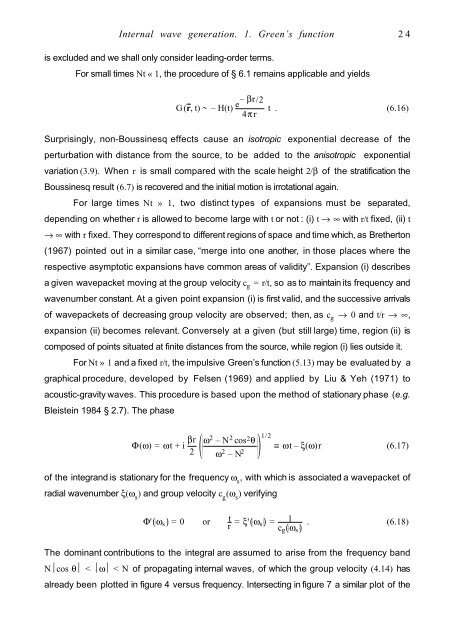Internal Wave Generation in Uniformly Stratified Fluids. 1 ... - LEGI
Internal Wave Generation in Uniformly Stratified Fluids. 1 ... - LEGI
Internal Wave Generation in Uniformly Stratified Fluids. 1 ... - LEGI
Create successful ePaper yourself
Turn your PDF publications into a flip-book with our unique Google optimized e-Paper software.
is excluded and we shall only consider lead<strong>in</strong>g-order terms.<br />
For small times Nt « 1, the procedure of § 6.1 rema<strong>in</strong>s applicable and yields<br />
G(r, t) ~ – H(t)<br />
e– βr/2<br />
4πr<br />
t . (6.16)<br />
Surpris<strong>in</strong>gly, non-Bouss<strong>in</strong>esq effects cause an isotropic exponential decrease of the<br />
perturbation with distance from the source, to be added to the anisotropic exponential<br />
variation (3.9). When r is small compared with the scale height 2/β of the stratification the<br />
Bouss<strong>in</strong>esq result (6.7) is recovered and the <strong>in</strong>itial motion is irrotational aga<strong>in</strong>.<br />
For large times Nt » 1, two dist<strong>in</strong>ct types of expansions must be separated,<br />
depend<strong>in</strong>g on whether r is allowed to become large with t or not : (i) t → ∞ with r/t fixed, (ii) t<br />
→ ∞ with r fixed. They correspond to different regions of space and time which, as Bretherton<br />
(1967) po<strong>in</strong>ted out <strong>in</strong> a similar case, “merge <strong>in</strong>to one another, <strong>in</strong> those places where the<br />
respective asymptotic expansions have common areas of validity”. Expansion (i) describes<br />
a given wavepacket mov<strong>in</strong>g at the group velocity c g = r/t, so as to ma<strong>in</strong>ta<strong>in</strong> its frequency and<br />
wavenumber constant. At a given po<strong>in</strong>t expansion (i) is first valid, and the successive arrivals<br />
of wavepackets of decreas<strong>in</strong>g group velocity are observed; then, as c g → 0 and t/r → ∞,<br />
expansion (ii) becomes relevant. Conversely at a given (but still large) time, region (ii) is<br />
composed of po<strong>in</strong>ts situated at f<strong>in</strong>ite distances from the source, while region (i) lies outside it.<br />
For Nt » 1 and a fixed r/t, the impulsive Green’s function (5.13) may be evaluated by a<br />
graphical procedure, developed by Felsen (1969) and applied by Liu & Yeh (1971) to<br />
acoustic-gravity waves. This procedure is based upon the method of stationary phase (e.g.<br />
Bleiste<strong>in</strong> 1984 § 2.7). The phase<br />
<strong>Internal</strong> wave generation. 1. Green’s function 24<br />
Φ(ω) = ωt + i βr<br />
2 ω2 – N 2 cos 2 θ<br />
ω 2 – N 2<br />
1/2<br />
≡ ωt – ξ(ω)r (6.17)<br />
of the <strong>in</strong>tegrand is stationary for the frequency ω s , with which is associated a wavepacket of<br />
radial wavenumber ξ(ω s ) and group velocity c g (ω s ) verify<strong>in</strong>g<br />
Φ' ωs = 0 or t r = ξ' ωs = 1<br />
cg ωs<br />
. (6.18)<br />
The dom<strong>in</strong>ant contributions to the <strong>in</strong>tegral are assumed to arise from the frequency band<br />
N⏐cos θ⏐ < ⏐ω⏐ < N of propagat<strong>in</strong>g <strong>in</strong>ternal waves, of which the group velocity (4.14) has<br />
already been plotted <strong>in</strong> figure 4 versus frequency. Intersect<strong>in</strong>g <strong>in</strong> figure 7 a similar plot of the


